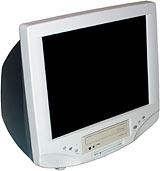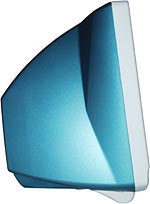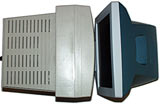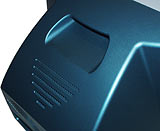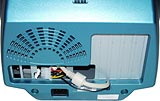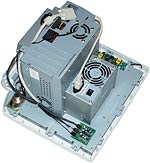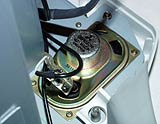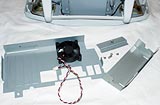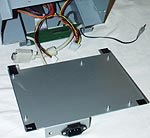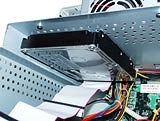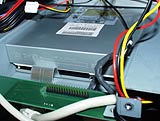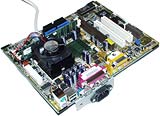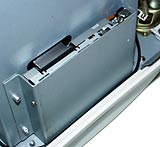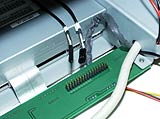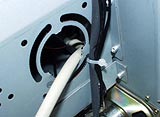
Palladine LCDpc
Review date: 1 September 2000.Last modified 03-Dec-2011.
Let's get the obvious out of the way first, shall we?
Singaporean company Palladine's LCDpc looks an awful lot like an iMac. There's no getting away from it. One box, curvy, blue (grey and white versions are also available), front mounted drives.
But this is actually a quite different critter.
It's a PC, for a start, not a Mac.
And it uses standard PC components. Standard microATX power supply. Standard microATX or FlexATX motherboard (you can find information on these teeny-PC standards here - the components are available all over the place). Standard CPU, standard RAM, standard video card, standard hard drive. Standard keyboard and mouse, too.
You need a slightly unusual shorter-than-normal CD-ROM drive, but these are easy enough things to find for the system assemblers that'll be building most LCDpcs.
Apparently, you can get not just CD-ROM but also DVD-ROM, CD-RW and even combined DVD-ROM/CD-RW drives that'll fit.
Palladine make much of the LCDpc's standard-ness, because it lets system assemblers easily upgrade the specifications of their LCDpc-based products. They buy "bare bones" LCDpcs, with floppy drive and power supply and screen and case but with no other giblets, and they can use whatever other components they like to fill the gaps.
The LCDpc is also small. Really small.
The screen's a full 15 inch 1024 by 768 unit, but it's a flat panel Liquid Crystal Display (LCD), not a Cathode Ray Tube (CRT) as is used by most computers, including the iMac. LCDs use less power, but their main selling point is that they take up very little space. Without a big fat tube in there, the svelte rear of the LCDpc holds all of the rest of its components.
Here's the profile view of the LCDpc...
...and here it is compared with an ordinary 15 inch CRT monitor.
It's about 360mm high, 380mm wide, and only 270mm deep (14 by 15 by 10.5 inches). An iMac is slightly taller, no wider, but a lot deeper - 381 by 381 by 435mm (15 by 15 by 17.1 inches), for current models, or a smidgen bigger for older ones.
The LCDpc's tiny footprint makes it an excellent option for applications where there just isn't room for a full sized PC and monitor. Or, of course, for people who merely want a nifty looking baby-PC.
The front panel has the usual power and reset buttons, plus four monitor-setup buttons. Pressing the "Exit" button by itself activates the LCD's auto-configure function, that matches the LCD's size settings to the input video signal.
Portability
The LCDpc has an iMac-ish carry handle on the top, neatly placed to keep the whole package balanced. The light weight of the LCD means even the most slightly built users should have no trouble carting the computer around.
Fully loaded, the LCDpc weighs less than ten kilograms, plus the weight of the keyboard and mouse. That's about the same as the weight of an ordinary steel-cased midi-tower PC, without its monitor.
A current model iMac is about six kilos heavier than the LCDpc. Original model iMacs weigh about 1.5 kilos more again.
The primary down side of the flat panel design, though, is price. LCD screens aren't cheap, and this one pushes the price of the LCDpc above $AU2500, depending on the CPU, memory and hard drive options. It's likely to be considerably more expensive than an iMac with similar storage.
The cheapest 15 inch stand-alone flat panel monitors still cost $AU2000. So you're paying no more for the rest of the LCDpc package than you would for a boring beige-box machine with the same hardware.
The secondary down side of the LCD is that it's a fixed-resolution display device. It can display other resolutions than 1024 by 768, but it's not pretty when it does.
LCD panels have an exact number of horizontal and vertical pixels. If you want to display a higher resolution than the real pixel number, the screen has to squish pixels together and do weighted averaging to determine what colour it should make the pixels it actually has, to try to give the impression that it's got more.
For this reason, you can usually only set the resolution one step higher than the real pixel number, to avoid complete illegibility.
If you want to display a resolution lower than the pixel number, an LCD either has to put the smaller display in the middle of the screen with a black border around it, or stretch the pixels - mapping each source-signal pixel onto some fractional number of actual display pixels.
The LCDpc doesn't black-borderise lower resolutions, it scales them up. 640 by 480 therefore looks quite dodgy, but 800 by 600's not too bad. 1024 by 768 is sharp and lovely. Anything higher is ugly again.
Ordinary 17 inch CRT monitors sell for only $AU500. And most "17 inch" CRTs have about a 16 inch diagonal viewable area, which means more than 10% more viewable area, for a quarter of the price of a 15 inch LCD.
17 inch CRTs commonly weigh 15 kilos all by themselves, of course, but if smallness and portability isn't your top priority, LCDs really aren't very attractive.
Inside
I got a completely bare-bones LCDpc to play with, with the standard-issue floppy drive and power supply, but nothing else. And with no documentation at all. Which certainly made putting the machine together more puzzling than it would have been with a manual.
Because it doesn't have a CRT in it, the LCDpc is as safe to fiddle with as any other PC. This is significant, because one-box computers have the potential to be quite dangerous.
The yoke on the back of a CRT is a very high voltage chunk of nastiness, supplied by big fat high voltage capacitors that can stay charged for ages after power has been removed, and near which it is generally advisable to work with one hand behind your back.
TVs and monitors have the second most dangerous power supplies in the average home or office. They're well behind the risk to life and limb presented by the magnetron power supplies in microwave ovens, but they're still not something for Joe Average to fool with.
The iMac does a decent job of keeping casual upgraders away from the nasty stuff - and, famously, you can add more RAM using no tool but a coin. But older one-box Macs, and various other attempts at the concept, leave the yoke just sitting there begging to be touched.
To connect to the motherboard's sound and video connectors, the LCDpc has a standard 15 pin monitor lead and a stereo 1/8th inch plug which come out of the back and loop around to the ordinary motherboard connectors. This isn't the most elegant looking solution ever, but it has some distinct advantages. You can easily plug an LCDpc into any monitor you like, and you can use a monitor extension cable to use a turned-on LCDpc as a monitor for another machine.
The back of the LCDpc comes off easily, once you remove four screws, and leaves you looking at the guts of the system. The little box is the power supply, a standard 145 watt microATX unit. The bigger box is where the motherboard and drives live.
This bracket lets you screw in expansion cards, the backs of which poke out through the (currently covered) slots below it, just as in a normal PC.
The slot covers are cheapo stamped-metal jobs; once they're punched out, you can't replace them. You should be able to put real slot covers from any other case in their place if you want, though. Anywhere that assembles computers will have bins full of the things.
The two built-in speakers are teeny portable-TV jobs. They sound OK, considering their tininess, but nobody's going to be using this thing as a boom box.
The loop-around rear audio connection, of course, means that you can plug in better speakers whenever you like. Or connect the LCDpc's speakers to something else with a 1/8th inch socket, for that matter. Your Walkman, say.
There are two cooling fans - the ordinary 80mm one inside the power supply, and a smaller 60mm one on the back of the component enclosure. The second fan's a three-wire speed-monitor type, which you can run from the case-fan connector on recent motherboards, including, I think, every board that'll fit in the LCDpc.
Remove a few pieces of metalwork...
...and you get access to the internal bay, which has a slide-out tray for the motherboard. The tray has pre-mounted standoffs to match all microATX/FlexATX motherboards.
With the tray out, you can mount the hard and CD-ROM drives before you install the motherboard.
The LCDpc takes a normal 3.5 inch hard drive, which mounts inverted on the top of the main bay. Modern hard drives work fine upside down, or lying on their side for that matter.
You screw the drive in place using the standard, though seldom-used, bottom screw holes. You can only use three of the four holes, but that's quite enough for a solid installation.
The short CD-ROM drive. A normal-length one will work in a pinch, but it'll stick out of the front panel in a most inelegant way.
The CD-ROM mounts in a bay under the motherboard tray.
I installed an ASUS CUV4X-M Socket 370 motherboard in the LCDpc. The CPU's a 533MHz Celeron, which is only a $AU210 processor these days.
The video card is an unexciting old Trident Blade3D based board which I happened to have sitting around. Pretty much any video card will work fine with the LCDpc's screen. Many microATX and FlexATX motherboards have video built in, and don't need a video card at all; they'll all work too.
The CUV4X-M has integrated sound, so I didn't need a sound card.
You can get Socket A motherboards in the microATX form factor, which lets you use AMD's excellent Athlon and very good value for money Duron CPUs. But you may have problems running these somewhat power-hungry processors from a standard 145 watt microATX power supply. For safety, I'd stick with the Intel CPUs, unless you can find a higher powered PSU that's microATX sized.
Mounting the motherboard on the tray is easy enough. Cramming the tray back into the case, on the other hand, is awkward.
You have to fold the floppy and IDE cables under the motherboard plate, and plug in the motherboard power cable when the board's partially inserted.
The power and reset header connectors are short enough that you have to fiddle them onto the appropriate pins on the motherboard when it's most of the way into the case; when, exactly, depends on where the motherboard you choose keeps its case connector header.
If the header's on the front edge of the board - the side that goes in first - then it'll be an easier job.
The laptop-style low-profile floppy drive, which comes standard with the bare machine.
Here's the floppy drive connection board. The drive itself connects to this board with a flat cable that threads under the CD-ROM drive, and the board has a standard 34 pin header for you to hook it up to the motherboard. There's a power connector, too, that takes a standard floppy power plug.
Well, I think that's how it works, anyway. The floppy drive in the LCDpc I checked out never showed the slightest sign of life. The main ribbon cable was definitely the right way around (the plug orientation's marked on the underside of the board).
I thought I might have got the floppy drive power connector backwards, but I don't think so; a bit of multimeter work revealed that either I had that plug right, or a pre-plugged connector was backwards or had the wrong colour wires, and the floppy wanted to run from 12 volts, not 5.
I gave the floppy up as a bad job, disabled it in the BIOS, and installed Windows 98 by booting from the CD-ROM drive. Like all current PCs, the LCDpc works fine without a floppy drive; you can do without one entirely if you're going to hook the computer up to a network, and you're using a network adaptor for which whatever operating system you're installing already has a driver.
In a pinch, you can plug in a modem, hit the Net and download drivers for anything you would otherwise get off a floppy. But I digress.
In use, the LCDpc was fine, as you'd expect it to be. It is, after all, just an LCD-screened small PC all squished into one box. The design of the thing makes it tilt up slightly, which in most setups will aim the screen at the user in a highly ergonomically satisfactory way.
You can use whatever keyboard and mouse you like, and as long as you don't need more resolution than the screen can manage or more expandability than microATX machines have to offer, an LCDpc is a perfectly adequate computer.
But it ain't no fun to work on.
To keep costs down, Palladine skimped on the LCDpc's build quality. It's solid enough, but there are sharp edges all over the place, and some really inelegant touches like this fan grille on the side, which has had its middle punched out and the monitor cable routed through the hole.
The edges of the hole are sharp and jagged, but no more risky for the cable (or your fingers) than the edges of every other hole that a cable passes through in this thing.
In the real world, I doubt any cables are going to be chafed through and cause problems, but it'd be quite possible to shear something by carelessly reassembling the LCDpc. You've got to wonder just how expensive a few simple plastic grommets could possibly be.
It'd be somewhat easier to put the LCDpc together if you used custom, two-connector cables for the CD-ROM and floppy drive.
Standard IDE cables have three connectors (one for the motherboard, one for the master drive, one for the slave), but it's not physically possible to get one to plug into both the CD-ROM and the hard drive in the LCDpc.
You have to use one cable to the hard drive, and a separate one to the CD-ROM, which is no problem because all normal PC motherboards for a long time now have had at least two IDE connectors.
Two-connector cables for all three drives in the LCDpc would reduce the clutter a bit, and stop cable connectors jamming under the motherboard tray. Normal floppy cables have four connectors, one of them a chunky 5.25 inch drive one, which makes them a considerable cable-snarl-contributor in the cramped confines of the LCDpc.
Palladine claim that "the chassis design provides much easier access to all internal components than with traditional PCs", which is a bunch of hooey. Traditional PCs do not require you to drag cables through small gaps just to build a basic three-drive machine, and they let you access the RAM, cards and CPU for upgrade purposes by, usually, removing two screws and one simple slide-off panel.
The LCDpc may be easier to work with than some other squished-together tiny-case machines, but if assembling PCs were my job, I'd much rather be assembling them in a bigger, conventional box.
Overall
If you're looking to kit out your office with a pile of basic Intel-based boxes, and saving space and looking spiffy are both priorities, then a pile of appropriately configured LCDpcs will fit the bill, provided you can afford them. At a given spec level, they'll perform just like identically configured normal PCs, but they take up a lot less room.
If you're a person that will be called upon to assemble LCDpcs if someone more important than you elects to buy the bare-bones systems, then out of pure self-interest I encourage you to argue strongly that the things are far too expensive to bother with.
Which is not a bad argument; an LCDpc is cheaper than a separate-box PC with a similar LCD screen, but it's $AU1500 or so more expensive than the same PC with a 17 inch CRT.
If your boss continues to be enthusiastic about LCDpcs, then I encourage you to fabricate evidence suggesting that they're unreliable and dangerous and cause birth defects in rabbits. There's no reason to believe any of these things, of course. LCDpcs are solidly constructed, and quite well ventilated, so there's no reason to suppose they won't give sterling service for ages.
But LCDpcs are also annoying to work on, compared with ordinary PCs. You don't want to do it. Trust me.
If you know what you're doing, assembling your own LCDpc is not excruciatingly painful. But it's not easy, and I still don't know what was up with that floppy drive.
Once an assembler had done a couple of the things it'd be simple enough to do more, but this is not a computer a beginner should work on.
If you're a home user, an LCDpc assembled for you by someone else may be expensive, but it's not a toy machine. It's obviously meant for pedestrian business and home purposes, but you could make a perfectly good, surprisingly high powered computer from an LCDpc base. Fast P-III, 384Mb RAM, Windows 2000, off you go.
With a 1024 by 768 ceiling display resolution, you're not going to be using this thing as a graphics workstation. But get a microATX motherboard with the full four possible expansion slots and you could make a perfectly all right little single-drive file server, ultra-portable LAN game party joy-machine, or projector-driving in-house presentation box.
For that last purpose, an LCDpc actually has a big price advantage, because most suited PowerPoint addicts drive their video projectors from high-priced laptops. If the extra bulk of the LCDpc is acceptable, it's a bargain compared with a laptop.
It's an interesting little beastie, this thing. I wouldn't mind using one all day.
But count me out if it needs an upgrade, OK?
